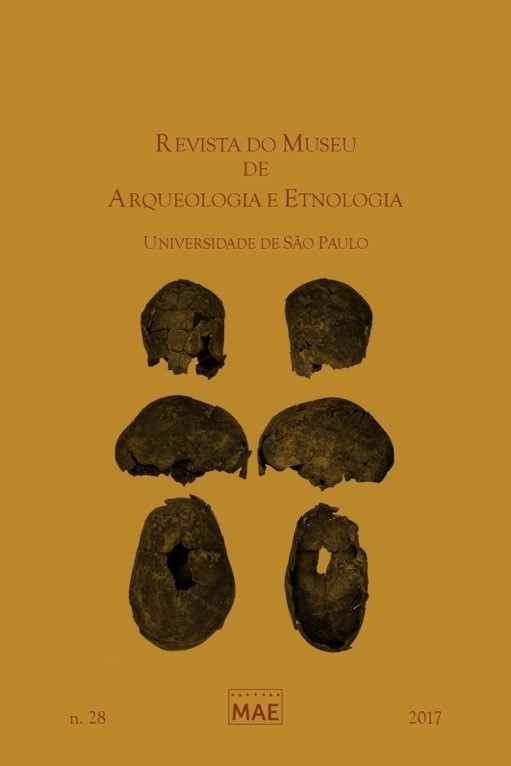Heaps of shells: situating artificial mounds of shells in Brazilian and Japanese prehistorical studies
DOI:
https://doi.org/10.11606/issn.2448-1750.revmae.2017.117588Keywords:
Sambaqui, Kaizuka, Brazilian Archaeology, Japanese Archaeology.Abstract
Archaeological sites marked by visible presence of shells can be found in different regions around the world. Named for their most visible characteristic, in Brazil they are known as sambaqui and in Japan as kaizuka. Shell mounds studies are part of local, regional and global research. Therefore, we aimed to situated shell mound studies among such research and questioning, and in a comparative perspective, we analyzed to what extent such studies are inserted into investigative lines that promote a global dialogue.
Downloads
References
CALIPPO, Flávio Rizzi. (2010). Sociedade sambaquieira, comunidades marítimas. Tese de Doutorado. Programa de Pós-Graduação em Arqueologia, MAE/USP.
GASPAR, Maria Dulce. (2004). Sambaqui: arqueologia do litoral brasileiro. Rio de Janeiro: Jorge Zahar.
HABU, Junko. (2004). Ancient Jōmon of Japan. Cambridge: Cambridge University Press.
HUDSON, Mark. (2005). For the people, by the people: postwar Japanese archaeology and the Early Paleolithic hoax. Anthropological Science, 113(2):131–139.
IMAMURA, Keiji. (1996). Prehistoric Japan. Honolulu: University of Hawai’i Press.
_______________. (2000a). Archaeological Research of the Jōmon Period in the 21st Century. In: SAKAMURA, Ken (ed.). Digital Museum 2000: Memory of Jōmon Period. Disponível em: http://www.um.u-tokyo.ac.jp/publish_db/2000dm2k/english/02/02-02.html
_______________. (2000b). Collections of Morse from the Shell Mounds of Omori. In: SAKAMURA, Ken (ed.). Digital Museum 2000: Memory of Jōmon Period. Disponível em: http://www.um.u-tokyo.ac.jp/publish_db/2000dm2k/english/02/02-03.html
KOBAYASHI, Tatsuo. (2004). Jōmon reflections – Forager life and culture in the pre-historic Japanese archipelago. Oxford: Oxbow Books.
LOUREIRO, André Garcia. (2003). Os aterros (cerritos) na fronteira Brasil – Uruguai: uma abordagem histórica e teórico-conceitual. Techné, Instituto Politécnico de Tomar, n.8.
MATSU’URA, Shuji; KONDO, Megumi. (2011). Relative chronology of the Minatogawa and the Upper Minatogawa series of human remains from Okinawa Island, Japan. Anthropological Science, 119(2):173-182.
MIZOGUCHI, Koji. (2002). An archaeological history of Japan – 30.000 BC to AD 700. Philadelphia: University of Pennsylvania Press.
________________. (2006). Archaeology, Society and Identity in Modern Japan. Cambridge: Cambridge University Press.
MORSE, Edward S. (1877). Traces of Early Man in Japan. Nature, XVII:89.
________________. (1879) Shell Mounds of Ōmori. Memoirs of the Science Department, 1(1).
NEVES, Walter; HUBBE, Mark; STRAUSS, André; BERNARDO, Danilo. (2014). Morfologia craniana dos remanescentes ósseos humanos da Lapa do Santo, Lagoa Santa, Minas Gerais, Brasil: implicações para o povoamento das Américas. Boletim do Museu Paraense Emílio Goeldi, Ciências Humanas, 9:715-740.
PROUS, André. (1992). Arqueologia brasileira. Brasília: Editora Universidade de Brasília.
RAGHAVAN, Maanasa et al. (2015). Genomic evidence for the Pleistocene and recent population history of Native Americans. Science, 349:6250
DOI: 10.1126/science.aab3884
ROMEY, Kristin. (2001). "God's Hands" Did the Devil's Work. Archaeology, 54(1), Archaeological Institute of America. Disponível em: archive.archaeology.org/0101/newsbriefs/godshands.html
SASAKI, Chūjirō; IIJIMA, Isao. (1880). Jōshū Okadaira kaikyo hōkoku. Gakugei Shirin, 6:91-110.
SCHIAVETTO, Solange. (2005). A questão étnica do discurso arqueológico: afirmação de uma identidade indígena minoritária ou inserção na identidade nacional? In: FUNARI, Pedro Paulo; ORSER, Charles; SCHIAVETTO, Solange. Identidades, discurso e poder: estudos da arqueologia contemporânea. São Paulo: FAPESP.
SEGUCHI, Noriko; MCKEOWN, Ashley; SCHMIDT, Ryan; UMEDA, Hideyuki; BRACE, C. Loring. (2011). An alternative view of the peopling of South America: Lagoa Santa in craniometric perspective. Anthropological Science, 119(1):21-38.
SKOGLUND, Pontus et al. (2015). Genetic evidence for two founding populations of the Americas. Nature, 525:104–108. DOI:10.1038/nature14895
WESOLOWSKI, V.; MENDONÇA DE SOUZA, S.M.F.; KARL REINHARD, K.; CECCANTINI, G. (2007). Grânulos de amido e fitólitos em cálculos dentários humanos: contribuição ao estudo do modo de vida e subsistência de grupos sambaquianos do litoral sul do Brasil. Revista do Museu de Arqueologia e Etnologia, 17.
YAMAGUCHI, Bin. (1990). The Hand Bones of the Jōmon Remains from the Ebishima (Kaitori) Shell Mound in Hanaizumi, Iwate Prefecture. Bulletin of the National Science Museum, Tokyo, ser. D, n.16.
________________. (1991). The Foot Bones of the Jōmon Remains from the Ebishima (Kaitori) Shell Mound in Hanaizumi, Iwate Prefecture. Bulletin of the National Science Museum, Tokyo, ser. D, n.17.
Downloads
Published
Issue
Section
License
Copyright (c) 2017 Silvia Reis, Claudia Rodrigues Carvalho

This work is licensed under a Creative Commons Attribution-NonCommercial-NoDerivatives 4.0 International License.













